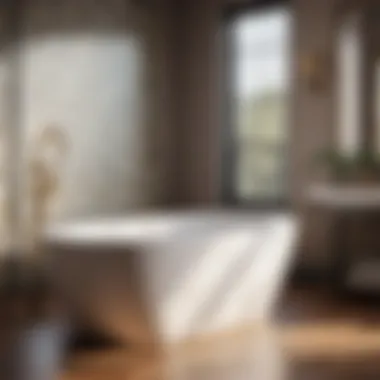Expert Tips for Perfect Bathtub Installation Process


Materials:
- Bathtub (standard size of 60 inches in length, 30 inches in width, and 16 inches in depth)
- Tub drain kit
- P-trap
- Overflow assembly
- Faucet fixtures
- Plumber's putty
- Plumbers wrench
- Adjustable wrench
- Screwdriver set
- Pipe cutter
- Measuring tape
- Level
- Silicone caulk
- Safety goggles
DIY Steps:
- Assess the Space: Measure the available area and ensure it can accommodate the bathtub dimensions specified. Ensure proper clearance for surrounding walls and fixtures.
- Prepare the Plumbing: Install the P-trap and overflow assembly according to manufacturer instructions. Connect the drain kit to the existing plumbing.
- Attach Faucet Fixtures: Secure the faucet fixtures to the bathtub, following the provided guidelines for proper alignment. Use plumber's putty to create a watertight seal.
- Position the Bathtub: Carefully lower the bathtub into place, ensuring it sits level and aligns with the plumbing connections.
Technical Aspects:
- Timing: Allow a full day for the installation process to ensure every step is completed accurately and efficiently.
- Usage of Tools: Proper utilization of a pipe cutter is crucial for precise pipe adjustments. A level ensures the bathtub is installed correctly.
- Unique Techniques: Applying silicone caulk along the seams enhances waterproofing and stability.
DIY Project Process:
- Mount the Bathtub: Secure the bathtub in place with adjustable feet and ensure stability using a level for balance.
- Connect Plumbing: Attach the drain kit and overflow assembly to the main plumbing lines, checking for leaks or loose connections.
- Final Touches: Apply silicone caulk around the edges of the bathtub to seal it effectively and prevent water leakage.
Troubleshooting Tips:
- If the bathtub doesn't align correctly, adjust the feet until it sits level.
- In case of leaks, inspect the connections and tighten as needed to resolve the issue.
- Properly caulk all seams to prevent water seepage.
Preparing the Space
When it comes to installing a bathtub, preparing the space is a critical first step that sets the foundation for a successful installation process. Without proper preparation, complications may arise down the line, leading to issues such as ill-fitting fixtures or inefficient water drainage. By ensuring that the space is adequately prepped, homeowners can streamline the installation process and avoid costly mistakes.
Measuring the Space
Determining the dimensions
Determining the dimensions of the designated space for the bathtub is crucial to ensure that the chosen bathtub will fit seamlessly. Measuring the length, width, and height of the area accurately is essential to prevent errors in selection and installation. By precisely establishing the dimensions, homeowners can confidently choose a bathtub that not only fits perfectly but also enhances the overall aesthetics of the space.
Clearing the area
Clearing the area where the bathtub will be installed is vital to create a safe and functional environment for the fixture. Removing any obstructions or debris from the space not only simplifies the installation process but also minimizes the risk of accidents during and after installation. Additionally, a clear area allows for easy access to plumbing and electrical connections, making maintenance and repairs more convenient in the future.
Assessing Flooring and Walls
Checking for water damage


Before installing a bathtub, it is essential to inspect the flooring and walls for any signs of water damage. Water damage can compromise the structural integrity of the installation area and lead to future issues such as leaks and mold growth. By identifying and addressing water damage early on, homeowners can prevent costly repairs and ensure the longevity of their bathtub installation.
Ensuring level surfaces
Ensuring that the flooring and walls where the bathtub will be placed are level is crucial for the stability and functionality of the fixture. Uneven surfaces can result in improper alignment of the bathtub, leading to drainage problems and potential leaks. Level surfaces not only facilitate a smooth installation process but also promote efficient water flow and proper functionality of the bathtub.
Ventilation Requirements
Installing vents if needed
Proper ventilation is essential in preventing moisture buildup and maintaining a healthy environment in the bathroom. Installing vents, if required, helps to decrease humidity levels, reduce the risk of mold growth, and enhance air circulation. By ensuring adequate ventilation, homeowners can prolong the lifespan of their bathtub and create a comfortable and safe bathing space.
Ensuring proper airflow
In addition to installing vents, ensuring proper airflow within the bathroom is paramount for optimal ventilation. Good airflow helps to prevent condensation, mitigate odors, and promote a fresh atmosphere. By incorporating ventilation features that facilitate adequate airflow, homeowners can create a pleasant and hygienic environment that complements their bathtub installation.
Gathering Tools and Materials
When it comes to installing a bathtub, gathering the necessary tools and materials is a crucial step that ensures the smooth progress of the project. Having the right tools at your disposal not only makes the installation process easier but also ensures the job is done correctly. One of the key benefits of focusing on this aspect is that it minimizes delays and minimizes the potential for errors during the installation. By having all the required tools and materials ready before starting the installation, you can streamline the process and achieve more efficient results.
Essential Tools
Wrench
The wrench plays a pivotal role in the installation of a bathtub as it is essential for tightening or loosening nuts and bolts throughout the process. Its key characteristic lies in its versatility and ability to provide the necessary torque for various fittings involved in installing the bathtub. The wrench's unique feature is its adjustable jaws, allowing it to fit different sizes, making it a versatile and practical choice for this article. While the wrench offers great utility, some of its disadvantages include the need for manual effort, which can be physically demanding, especially for larger or tighter fittings.
Level
Another essential tool for installing a bathtub is a level, which ensures that the tub is correctly positioned and aligned during the process. The key characteristic of a level is its ability to indicate horizontal and vertical alignment accurately, which is crucial for stable and visually appealing installation. Its unique feature of bubble vials allows for precise measurements and adjustments, making it a popular choice for ensuring a proper installation. Although the level offers accuracy and precision, one drawback is that it may require frequent adjustments, especially in older homes with uneven surfaces.
Screwdriver
A screwdriver is a must-have tool for bathtub installation as it is indispensable for securing screws and fasteners in place. Its key characteristic is its adaptability to different types of screws, providing the necessary torque for tightening or loosening them as needed. The unique feature of different tips for various screw heads enhances its versatility, making it a beneficial choice for this article. While the screwdriver is a versatile tool, one disadvantage is the potential for stripping screws if not used carefully, which can lead to complications during the installation.
Required Materials
Bathtub
The bathtub itself is a critical component of the installation process, and choosing the right one is essential for a successful outcome. Its key characteristic lies in its size, shape, and material, which should align with the space and design preferences of the homeowner. A key feature of bathtubs is their durability and ease of maintenance, making them a popular choice for this article. However, some disadvantages may include the weight of the bathtub, which can make handling and positioning challenging during installation.


Plumbing fixtures
Plumbing fixtures, such as faucets and drains, are essential materials needed to complete the bathtub installation. Their key characteristic is functionality and compatibility with the chosen bathtub, ensuring seamless water flow and drainage. The unique feature of anti-corrosive materials used in plumbing fixtures enhances their durability, making them a beneficial choice for this article. One potential disadvantage is the need for precision in installation to prevent leaks and ensure proper functionality of the fixtures in the long run.
Connecting Plumbing
When it comes to installing a bathtub, connecting plumbing is a crucial step that ensures proper functionality and longevity of the fixture. This section delves into the intricacies of this essential process, highlighting key elements and considerations for a seamless installation.
Installing a bathtub involves more than just placing the fixture in the designated space—it involves ensuring that the plumbing connections are secure and correctly aligned. Properly connecting the plumbing not only prevents leaks and water damage but also guarantees efficient water flow and drainage.
One primary benefit of focusing on connecting plumbing is the peace of mind it brings knowing that your bathtub will work effectively without any issues. By following the correct procedures and taking care to secure the water lines properly, you can enjoy a fully functional bathtub that enhances your daily routine.
Considerations such as the type of pipes, the quality of fittings, and the placement of water lines are vital in the plumbing process. Ensuring that the bathtub is positioned correctly to align with the existing drainage system is key to preventing future blockages or improper water flow.
Proper ventilation around the plumbing connections is also essential to prevent mold or mildew growth. By taking the time to connect the plumbing accurately during the installation phase, you can avoid costly repairs or replacements down the line.
Positioning the Bathtub
Aligning with Drainage
Aligning the bathtub with the drainage system is a critical aspect of the installation process. Ensuring that the bathtub's waste end aligns perfectly with the existing drainage opening is key to efficient water flow and proper functioning.
One of the key characteristics of aligning with drainage is preventing clogs and ensuring that water drains smoothly. By aligning the bathtub correctly, you reduce the risk of plumbing issues and maintain optimal performance.
A significant advantage of aligning with drainage is the reduction of water pooling or slow drainage, which can lead to unpleasant odors and potential water damage. This precise alignment ensures that water exits the bathtub promptly and efficiently.
However, a potential disadvantage of misaligning with drainage could result in backflow or blockages, requiring costly repairs or adjustments. Therefore, focusing on aligning the bathtub properly with the drainage system is a proactive measure to avoid future inconveniences.
Ensuring Proper Fit
Ensuring that the bathtub fits perfectly in the designated space is essential for a seamless installation process. A proper fit not only enhances the aesthetics of the bathroom but also ensures structural integrity and longevity of the fixture.
The key characteristic of ensuring a proper fit is the snug and secure placement of the bathtub within the space allocated. This snug fit prevents unnecessary movement or shifting, which can lead to unlevel surfaces or potential leaks.
One of the significant advantages of a proper fit is a visually appealing and functional bathroom environment. A well-fitted bathtub enhances the overall look of the space and provides a sense of cohesion and refinement.
On the other hand, a potential disadvantage of overlooking proper fit is the risk of instability or damage to the bathtub and surrounding structures. Therefore, meticulously measuring and adjusting the position of the bathtub ensures a perfect fit that withstands daily use without issues.
Securing Water Supply


Attaching Water Lines
Attaching water lines correctly is paramount to ensure a steady and reliable water supply to your bathtub. Properly secured water lines prevent leaks and fluctuations in water flow, allowing for a consistent and enjoyable bathing experience.
One key characteristic of attaching water lines is the use of quality fittings and securing techniques to prevent water wastage or damage. By employing the right tools and methods, you can establish a watertight connection that withstands long-term usage.
An advantage of attaching water lines securely is the uninterrupted flow of water to the bathtub, enhancing convenience and comfort during use. The assurance of a leak-free connection also contributes to water conservation and a sustainably designed bathroom.
However, a potential disadvantage of improper attachment is the risk of leaks, which can lead to water damage and increased utility costs. Therefore, ensuring that water lines are attached correctly is imperative in maintaining the functionality and efficiency of your bathtub.
Checking for Leaks
Regularly checking for leaks in the water supply system is a preventive measure that safeguards your bathroom against potential water damage and utility wastage. Detecting and addressing leaks promptly can save you both time and money in the long run.
The key characteristic of checking for leaks is thoroughness and attention to detail when examining water lines and connections. From visible drips to subtle moisture indicators, being proactive in leak detection can prevent extensive damage and costly repairs.
One advantage of consistent leak checks is the early identification of potential issues, allowing for timely interventions and maintenance. By staying vigilant and addressing leaks promptly, you preserve the integrity of your bathroom's infrastructure and prevent unnecessary water wastage.
On the flip side, neglecting to check for leaks can result in silent water damage, mold growth, and higher water bills. Taking the time to conduct routine leak inspections is a small yet effective investment in the long-term functionality and sustainability of your bathroom.
Sealing and Finishing
In the realm of bathtub installation, one of the pivotal stages is the sealing and finishing process. This section is crucial as it ensures the longevity and durability of your newly installed bathtub. By meticulously sealing joints and completing the necessary finishing touches, you not only enhance the visual appeal of your bathroom but also safeguard against potential water damage, which could compromise the integrity of your installation.
Sealing Joints
Using waterproof sealant
When it comes to using waterproof sealant, precision and quality are of the essence. Waterproof sealant plays a vital role in preventing water leakage and creating a watertight barrier around the edges of the bathtub. The key characteristic of using waterproof sealant lies in its ability to withstand water exposure and seal any gaps effectively. This proves to be a popular choice in this article as it ensures a secure and leak-proof bathtub installation. The unique feature of waterproof sealant is its adhesive properties, which provide a strong bond between various surfaces, offering excellent protection against water infiltration. While the advantages of using waterproof sealant are its reliability and long-lasting waterproofing capabilities, one consideration to keep in mind is ensuring proper application to achieve optimal results.
Preventing water damage
Preventing water damage is a critical aspect when sealing and finishing a bathtub installation. By implementing measures to prevent water damage, you safeguard your bathroom against mold, mildew, and structural issues caused by excess moisture. The key characteristic of water damage prevention methods is their ability to create a moisture-resistant barrier, ultimately preserving the integrity of your bathroom space. This practice is highly beneficial for this article as it reinforces the longevity of the bathtub installation and maintains the aesthetic appeal of your bathroom. An important feature of water damage prevention is its proactive approach to safeguarding against potential issues before they escalate. While the advantages of preventing water damage are evident in maintaining a healthy bathroom environment, it is essential to conduct regular inspections to ensure continued protection.
Completing the Installation
As you near the final stages of bathtub installation, completing the installation process encompasses various essential tasks to ensure functionality and quality. This section focuses on testing for functionality and conducting final inspections to guarantee a successful and durable installation that meets your expectations.
Testing for functionality
Testing for functionality is a critical step towards verifying that your bathtub installation operates as intended. By rigorously testing the components such as drainage, faucets, and water flow, you can identify any potential issues and address them promptly. The key characteristic of testing for functionality lies in ensuring that all plumbing connections are secure, and the bathtub functions efficiently without any leaks or malfunctions. This approach is a beneficial choice for this article as it emphasizes the importance of quality assurance in the installation process. The unique feature of testing for functionality is its focus on user experience, aiming to provide you with a seamless and enjoyable bathing experience. While the advantages of testing for functionality are evident in detecting and rectifying any operational flaws early on, one should carefully follow the testing procedures to avoid overlooking any underlying issues.
Final inspections
Conducting final inspections marks the concluding phase of the bathtub installation journey. These inspections involve a thorough review of the installation to guarantee its compliance with your specifications and industry standards. The key characteristic of final inspections is their attention to detail and scrutiny, ensuring that every aspect of the installation meets the required criteria. This practice is a popular choice for this article as it ensures a high-quality and satisfactory outcome for your bathtub project. The unique feature of final inspections is their comprehensive nature, covering all aspects from functionality to aesthetics, to deliver a flawless end result. While the advantages of final inspections include peace of mind and quality assurance, it is advisable to engage professional inspectors for a meticulous assessment, thereby minimizing the risk of oversights and errors.







